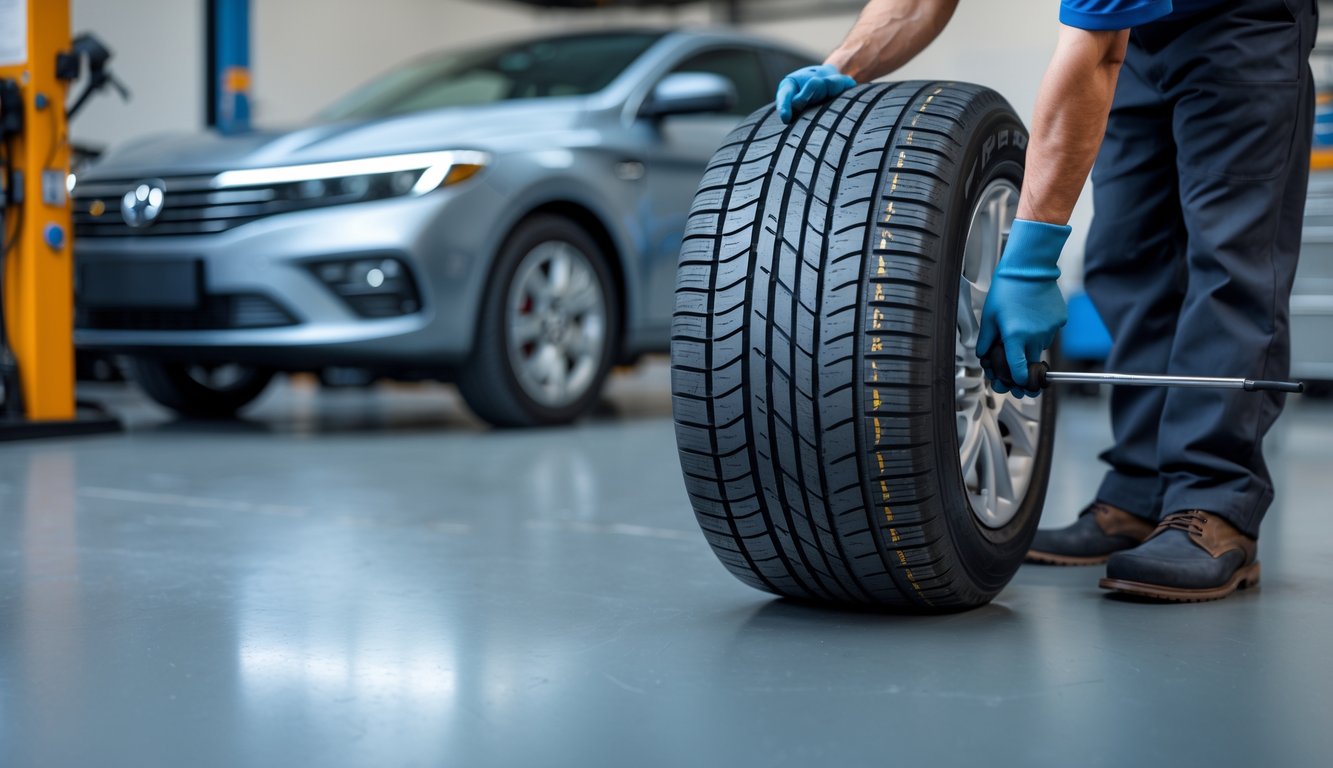
Risks of Improper Tire Rotation
Tire rotation—sounds boring, right? Just move tires around, no big deal. But skip a step, mess up the order, and suddenly your “routine” maintenance is quietly wrecking your safety, your bank account, and your peace of mind. Or maybe that’s just me being dramatic.
Uneven Tread Wear and Reduced Traction
It seems harmless—miss a rotation, swap them however, close enough. Except it’s really not. My mechanic showed me how tires on different axles wear in crazy ways, especially on front-wheel-drive cars. I didn’t believe him until I checked with a tread gauge (okay, a penny), and wow—the fronts were basically slicks, rears still had grooves.
All that uneven wear? It kills traction, especially in the rain or on cold roads. The folks at Kicked Tires say they see uneven wear in almost 60% of cars during checkups. Not even surprised. If your tread depth isn’t consistent, handling gets weird fast.
Manufacturers say rotate every 5,000–7,500 miles, but honestly, it’s not about the number—it’s about spreading out the pain. Skip rotations and you’ll lose grip before you notice. Those fancy sipes and channels? They’re not just for show. One rainy day and suddenly the car feels like it’s on ice.
Decreased Handling and Steering Problems
Ever had your steering go numb? I blamed “road feel” until I realized I’d skipped two rotations. Turns out, that’s how bad handling sneaks up. Lazy steering, delayed response, weird pulling on the highway—all because the tread is uneven and the car can’t decide which way to go.
If your tires are mismatched, the car starts pulling or wandering. Try that in a curve or lane change and it gets sketchy. My friend’s Subaru started making weird noises—he skipped rotations, ended up with cupping, and his gas mileage tanked. Awesome.
Oh, and warranties? They love to void themselves if you skip or screw up rotations. I got a rejection letter once and it ruined my week. Not even a free coffee for my trouble.
Potential for Tire Failure or Hydroplaning
I used to think blowouts just happened—bad luck, some nail, whatever. Then I hydroplaned through a puddle, lost steering for a second, and nearly lost my lunch. Turns out, heat builds up in worn, unrotated tires, lets moisture collect, and then, according to cityautorepair.com, you’re way more likely to blow a tire or lose grip when you need it most.
Tire companies warn about this constantly. Hydroplaning isn’t just about “driving slower in the rain.” If your tread can’t channel water, you’re basically skating. When the sharp patterns wear unevenly, the air pockets disappear, and you’re stuck. The risk of getting stranded, or worse, causing a pileup, goes up fast.
And yeah, warranty? Forget it if you can’t prove rotations. I’ve had three shops deny a pro-rated replacement for “improper rotation history.” It’s never just about the tread—skip this and you’ll regret it sooner than you think.
Directional and Non-Directional Tires: Key Differences

Nobody obsesses over tire treads until it’s too late. You’re rotating tires and suddenly those weird arrows or patterns you ignored are a problem. Directional tires are picky—they have to go a certain way. Non-directional tires? They don’t care, they’re chill. Ignore the difference and it’s not just about wear; you’re risking traction, hydroplaning, and maybe losing your warranty.
What Are Directional Tires?
Directional tires look cool in pictures, less so on my crusty Subaru. They’ve got these aggressive V-shaped grooves, all pointing one way. Not for style—it’s to push water out fast and keep you from hydroplaning at speed.
Mount them backwards and you’ll probably regret it. I’ve seen people lose control after a rainstorm. Tire guys always say, “Follow the arrows or else.” If you can’t find an arrow, grab a flashlight—it’s probably hiding with some tiny “Rotation” text or a triangle. Even the Bridgestone Potenza RE980AS+ does this. You can only rotate these front-to-back. Side-to-side? Nope, unless you want to wear them out weird and lose all the benefits.
Rotating Non-Directional Tires
Non-directional tires—honestly, they’re the easy ones. Symmetrical, maybe a little asymmetrical, but they don’t care what corner they’re on. You can crisscross them, swap them however, and the tread won’t complain.
A mechanic in Chicago once told me he swapped non-directional tires corner-to-corner every 5,000 miles, never had a problem. Manufacturers keep saying: just keep the tread depth even, it’s not optional. I use a penny to check mine—who actually owns a tread gauge? Miss a rotation and you’ll hear thumping on the highway, plus you can kiss your warranty goodbye. If you want the nitty-gritty, here’s a deep dive on non-directional tires.
Rotation Patterns by Tread Design
Can we talk about tire rotation patterns? Because, honestly, every article claims something different and I’m not convinced anyone actually agrees. Directional tires—those are the ones with the fancy arrows—just swap front to back. That’s it. Try anything else and you’ll probably just make things worse. Non-directional? I’ve stared at so many criss-cross diagrams my eyes went blurry. And yeah, apparently it changes depending on whether your car pushes, pulls, or does both. Super helpful.
I’ve literally watched tire shop employees argue about rotation patterns by tread design. AWD, FWD, RWD—they all want their own special dance. Cross, X, straight, whatever. My buddy once asked if tires “remember” their old spots. They don’t, but your steering wheel sure does if you ignore what the manual says. Here’s a table that looks straightforward but, like, it’s not:
| Tread Design | Allowed Patterns | Not Allowed |
|---|---|---|
| Directional | Front/back only | Cross, side-to-side |
| Non-Directional | Any (front, back, cross) | Mounting backwards |
Honestly? The best rotation pattern is the one you can actually remember to do before your tires look like a failed geometry project.
